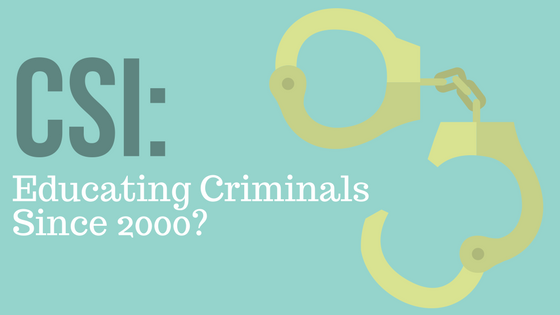The television show, CSI (Crime Scene Investigation), was first introduced to viewers in 2000, and for 15 years, viewers followed Gil Grissom and, later, D.B. Russell and their team of criminologists as they used physical evidence to solve crime in Sin City.
While CSI was just one of many crime dramas using forensic science to find the bad guy, it was the show used to originate the term CSI effect – a term used to describe the concern that public perception would be shaped by these shows. Would juries now have higher expectations when it came to what forensic laboratories could do and evidence presented in during trials?
written by: Tara Luther, promega
We examined the CSI effect more fully In a previous post shared in 2016. Now, a new study published in the International Journal of Law, is the first to ask whether criminals benefit from watching television shows focusing on forensic science, or, what they coined as the CSI-education effect.
The CSI-education effect consists of three claims:
- The percentage of resolved rape cases has decreased in the United States since CSI first aired in 2000.
- Criminals actively seek out crime series, such as CSI, for tips and advice on how to get away with crime.
- People who watch these types of shows are better at avoiding detection after they commit a crime.
In order to find out once and for all if the CSI-education effect exists, Baranowski et al of Johannes Gutenberg-University in Germany employed four studies with mixed methodologies to ensure accuracy of the results.
First, the team analyzed crime clearance rates in the United States and Germany prior to 2000 and after CSI was released. A crime was considered cleared when an offender was identified, arrested, charged, and then turned over to the court. They theorized that if the CSI-education effect were real, the clearance rate should decrease over time, assuming the clearance rate was not already in decline. The team used databases provided by the German Federal Bureau of Investigation and the American Federal Bureau of Investigation for the years 1993-2012 for their research. Using these databases, Baranowski et al determined that the clearance rate for murder and rape was significantly lower after 2000 in the United States, though they determined this not to be the cause of the CSI-education effect. On the flip side, all clearance rates aside from theft increased in Germany.
Baranowski et al found many flaws in using clearance rates, so they decided to go right to the source and asked 24 German male convicted criminals whether or not they found forensic crime series to be educational. Through a series of testing, they found that while all inmates had reported watching many episodes of CSI, and thought that information could be gleaned from the shows, none of them had actually used the series as a source of information for their crimes, instead citing their friends and acquaintances. Though the team had asked received their answer from convicted criminals, they figured it was possible that some criminals had learned from shows like CSI and therefore hadn’t been incarcerated, which called for additional testing.
Next, they asked both a group of “extreme” crime drama viewers and non-viewers to pretend to be a criminal by first stealing a laptop and then cleaning a miniature “crime scene” of evidence. Baranowski et al also administered a questionnaire to the subjects asking them about their education, monthly income, professional background of their parents, and their interest in forensics. While both groups left a similar amount of forensic traces while stealing the laptop, the team noted that education seemed to be an important predictor in how well someone performed in the study. In contrast, they did note some of the best performers to have the lowest education, though they explained this away through the subject’s choice in profession, as those with technical jobs or engineers did the best. Interestingly, the team noted that those who performed the best had an interest in forensic science, but did not watch many forensic television shows.
Through these studies and experiments, Baranowski et al came to the conclusion that there wasn’t sufficient evidence to point toward a CSI-education effect. They did, however, acknowledge that as a whole, criminals have gotten smarter. They attribute this to the tech effect – the assumption that criminals’ knowledge has increased along with that of law enforcement.
WOULD YOU LIKE TO SEE MORE ARTICLES LIKE THIS? SUBSCRIBE TO THE ISHI BLOG BELOW!


